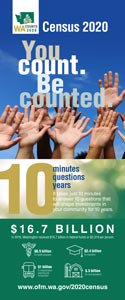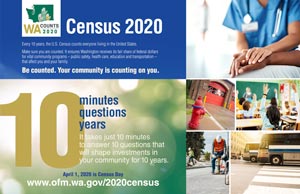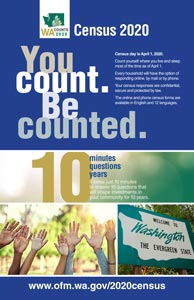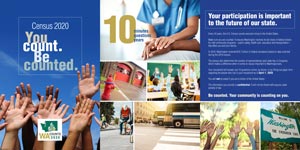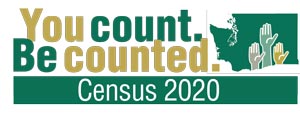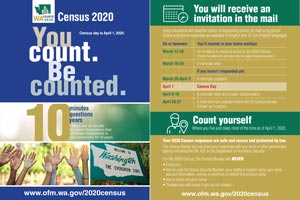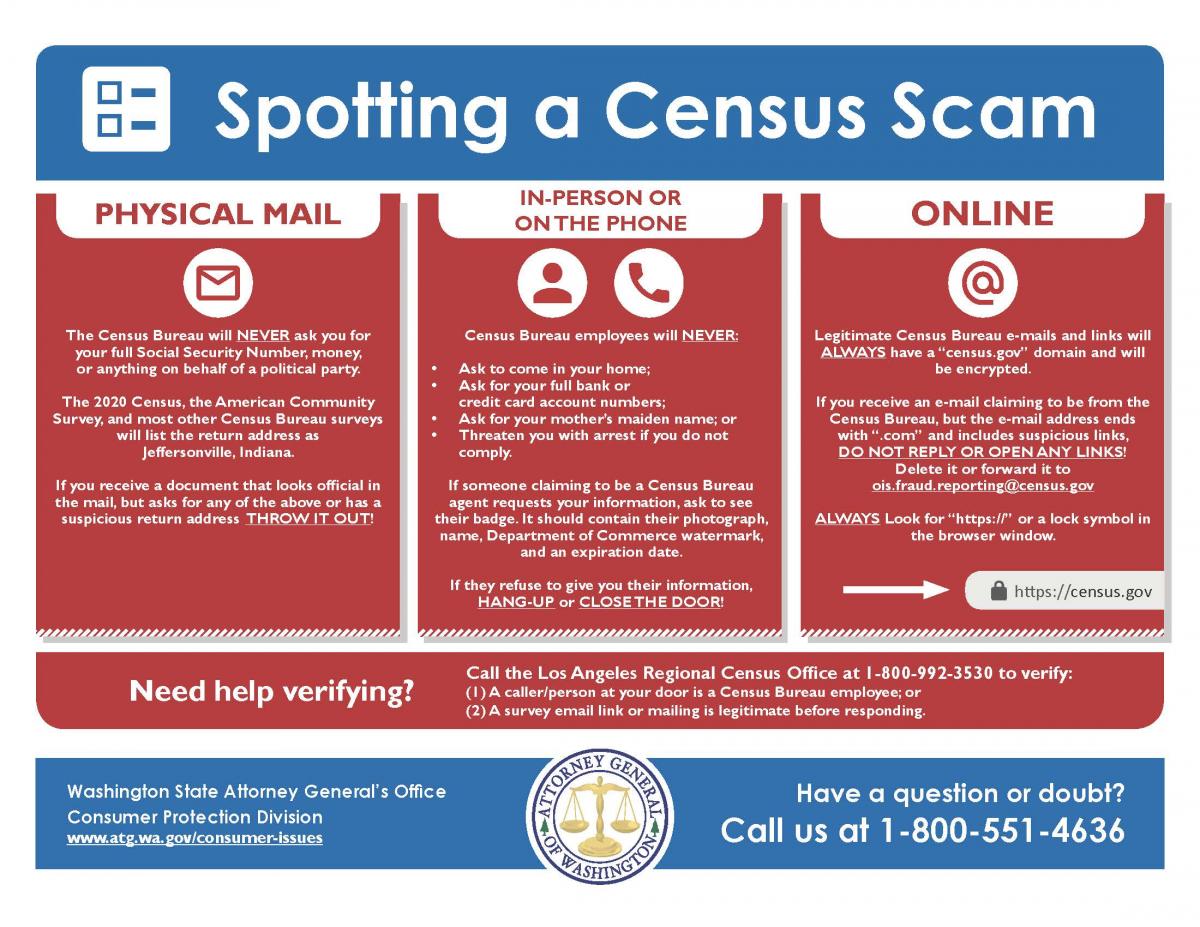Preparations - 2030 Census
In This Section
Hard-to-count population – 2020 Census
Understand the typology of hard-to-count (HTC)
In every census, there are certain socioeconomic and demographic factors that include age, housing status, and language that can influence self-response. The traditional socioeconomic and demographic factors that have tended to correlate with lower levels of self-response have included:
- People of color
- Low-income or no-income households
- Populations under 5 years of age
- Rural residents
- Limited English Proficiency
- Frequent movers or renters
- Large or single-parent households
- People experiencing homelessness
- Foreign-born residents
- Low educational attainment households
- People who distrust government authorities or could be targets of law enforcement
The 2020 Census is the first occasion that online is the Census Bureau’s preferred method of self-response. New socioeconomic and demographic factors may influence response rates, including older residents, households without computers or homes with inadequate access to the internet. You will want to reflect on your community and decide what factors might have an influence on participation – and it may differ from that which has been true in the past.
See it in maps
OFM
For each county in Washington, OFM has created tract and block group-level maps highlighting hard-to-count areas based on a variety of factors related to response rates.
U.S. Census Bureau
The U.S. Census Bureau’s planning database, which combines information from the last census and the American Community Survey, can be used to identify hard-to-survey areas. The Bureau developed the Response Outreach Area Mapper to use the planning database’s information to identify hard-to-count areas.
Other data
Improving the Count of Young Children
The 2010 census missed more than 10 percent of all children under age 5 living in the United States. The failure to accurately capture data on young children has serious consequences for them, their families, their communities and the nation – with many of those consequences lasting for at least 10 years. The Count All Kids Committee is working with the Census Bureau to help them improve their plans to reach out to families with young children. Share this short YouTube video with your networks to help spread the word about the importance of counting all kids!
Internet access
Data from the 2013-2017 American Community Survey highlights households (number and percentage): (1) with no internet access, and (2) with access to the internet only through their cellphones. Data posted includes information by county, city/town and census designated places. This information will be important for communities throughout the state as everyone organizes for the first decennial census in March and April 2020 where the preferred method of self-response will be the internet.
In addition, the Federal Communications Commission (FCC) has mapped the number of residential fixed Internet access service connections per 1,000 households as of December 2016 based on broadband subscribership data. The map gives a view down to the census tract of service exceeding 200 kbps in at least one direction and service of 10 Mbps downstream/1 Mbps upstream.
Limited English proficiency
Counting the homeless population
The Census Bureau has defined an area as hard to count (HTC) if the self-response rate in the 2010 Census was 73% or less.
The Census Bureau’s Planning Database includes HTC scores along with American Community Survey (ACS) data at the tract and block group level. You can use this data to target your 2020 Complete Count efforts.
- Planning database
- Planning database WebEx presentation
- Response Outreach Area Mapper application
- Census Engagement Navigator – this interactive, data visualization allows users to quickly understand what areas had high or low return rates in the 2010 census, and the current demographic makeup of these neighborhoods.
- Outreach Toolkit
Counting people experiencing homelessness during the 2020 Census
The intent of the 2020 Census is to count everyone living in the United States, including people experiencing homelessness or living in transitory locations. General information about how the homeless will be counted and categorized in the 2020 Census results is provided below, as well as references to more detailed explanations.
- The 2020 Census will count people wherever they live on Census Day (April 1, 2020)—or where they are staying that day if they have no permanent place to live.
- The Census Bureau recognizes that people experiencing homelessness live in a variety of situations, such as temporarily staying with family or friends, living at a shelter, living outside, living in a tent or living in a car or recreational vehicle (RV). The Census Bureau also recognizes that some people are living in transitory locations without another usual home elsewhere.
- The effort to count people experiencing homelessness at service locations and pre-identified outdoor locations is referred to as Service-Based Enumeration (SBE). SBE will count people at shelters, soup kitchens, regularly scheduled mobile food vans and target non-sheltered outdoor locations on March 30, March 31 and April 1, 2020.
- The Bureau’s Enumeration at Transitory Locations Operation (ETL) enumerates people who are living in special locations such as recreational vehicle parks, campgrounds, racetracks, circuses, carnivals, marinas, hotels and motels and who do not have a Usual Home Elsewhere. ETL data collection will be conducted from April 9 to May 4, 2020.
- In the summer of 2019, OFM will submit as many SBE and ETL locations as it has time to collect in the first half of the year. Participation in the New Construction Program (September-November 2019) will be an important—and last—chance for all localities to update information about homeless shelters and transitory locations.
The process of service-based enumeration and enumeration at transitory locations builds on decades of work with national and community-based organizations and will involve:
- Work with state, local and tribal governments nationwide to update contact and address information for service-based locations (including shelters, soup kitchens and regularly scheduled mobile food vans) and transitory locations.
- Work with local groups to identify outdoor locations where people are known to sleep, such as under bridges and in tent camps, or to stay temporarily.
- Work with local community to identify recruiting needs that may include specific language skills and cultural facilitators.
While the tables for the 2020 Census results have not been finalized, the enumerated homeless population will likely be represented in the group quarter population under the “other noninstitutional facilities” category. This category includes the homeless, adults living in group homes, adults living in residential treatment centers and those living in maritime/merchant vessels, job corp centers, religious group quarters, natural disaster housing and domestic violence shelters.
The U.S. Department of Housing and Urban Development provides official statistics on the total population experiencing homelessness through their annual Point-in-Time counts. You can find the latest counts for Washington on the website of Washington’s Department of Commerce.
For more details
For more information on the Census Bureau’s detailed plans for 2020, see:
- Detailed Operational Plan for: 15. Group Quarters Operation – Pages 51-51 provide information on Service-Based Enumeration (SBE).
- 2020 Census Operational Plan v.4 – Pages 118-119 provide detail about the Enumeration at Transitory Locations (ETL).
Background
For information on the counts from the 2010 Census, see:
- The 2010 Census table PCT20 on Group Quarters Population by Group Quarters Type
- “The Emergency and Transitional Shelter Population: 2010” special report
Other sources of information on the population experiencing homeless include:
2020 hard-to-count areas – interactive maps
Timeline – 2020 Census
Updated timeline of operations due to COVID-19
The decennial U.S. Census has been characterized as the largest peacetime mobilization. It’s a complex exercise that involves 35 separate operations, according to the U.S. Census Bureau. Just as the data collection effort began, the nation shut down due to COVID-19.
| Activity/operation | Original schedule | New schedule |
|---|---|---|
| Self-response phase – online, phone, and mailed self-responses continue throughout the data collection process. | March 12-July 31 | March 12- September 30 |
| Group quarters (e-response and paper enumeration) | April 2–June 5 | April 2- September 3 |
| In-person group quarters enumeration | April 2–June 5 | July 1 – September 3 |
| Update leave – census takers drop off invitations to respond and paper questionnaires at the front doors of 5 million households stateside while updating the addresses. | March 15–April 17 | Resumed May 11 |
| Non-response follow-up (NRFU) – census takers will conduct in-person interviews of households that have not self-responded. | May 13–July 31 | July 23 – September 30 |
| Mobile questionnaire assistance – Census Bureau staff assists people with responding online at places people gather (grocery stores, etc.). | March 30-July 31 | July 13 – September 30 |
| Service-based enumeration – working with service providers at soup kitchens, shelters, and regularly scheduled food vans to count the people they serve. | March 30-April 1 | September 22-24 |
| Count of people experiencing homelessness outdoors | April 1 | September 23-24 |
| Enumeration at transitory locations – census takers count people staying at campgrounds, RV parks, marinas, and hotels if they do not usually live elsewhere. | April 9-May 4 | September 3-28 |
| Deliver apportionment counts to the president | By December 31, 2020 | April 26, 2021 |
| Deliver redistricting counts to the states | By April 1, 2021 | Late August 2021 |
2020 Census promotional materials
These promotion materials are available for download here.
